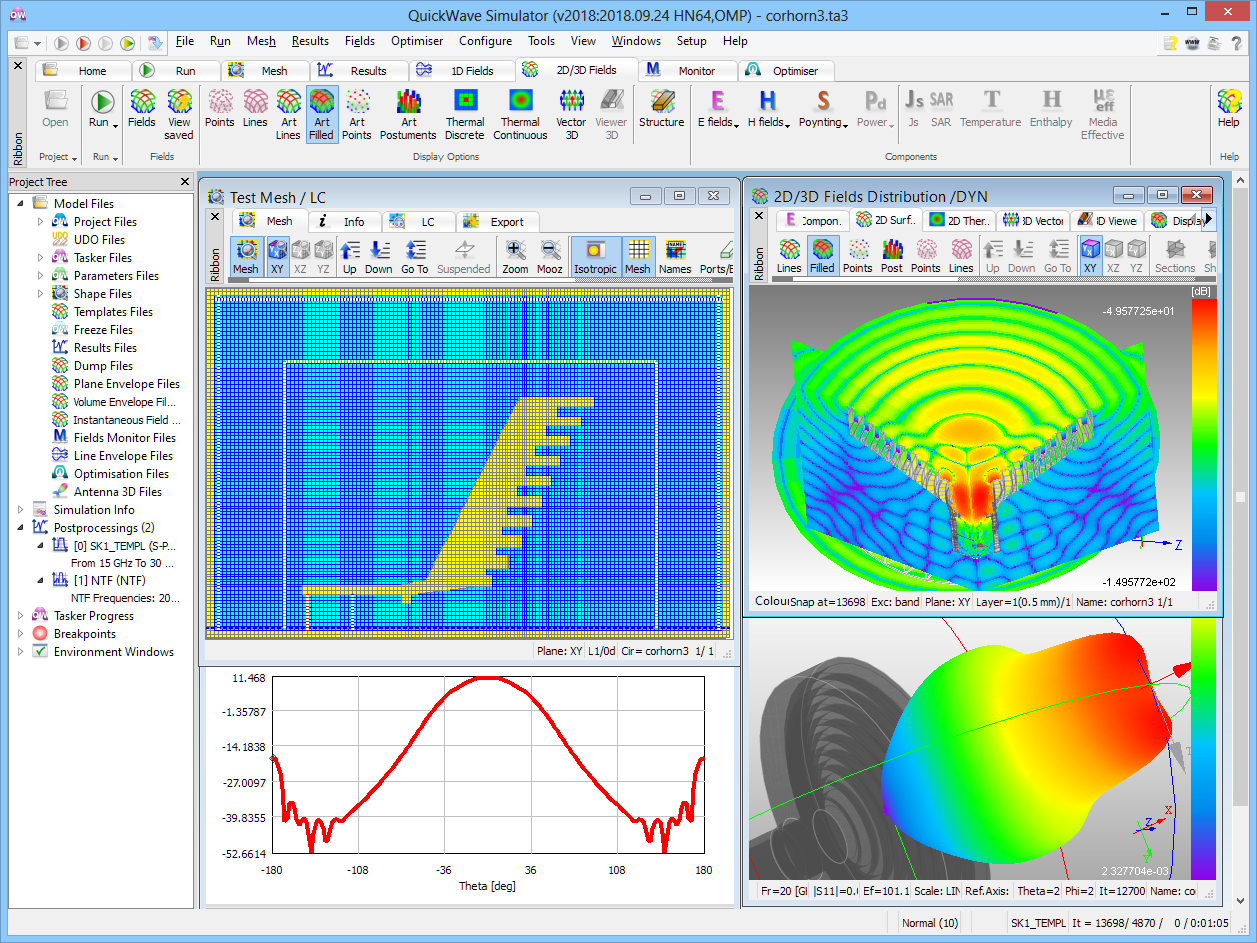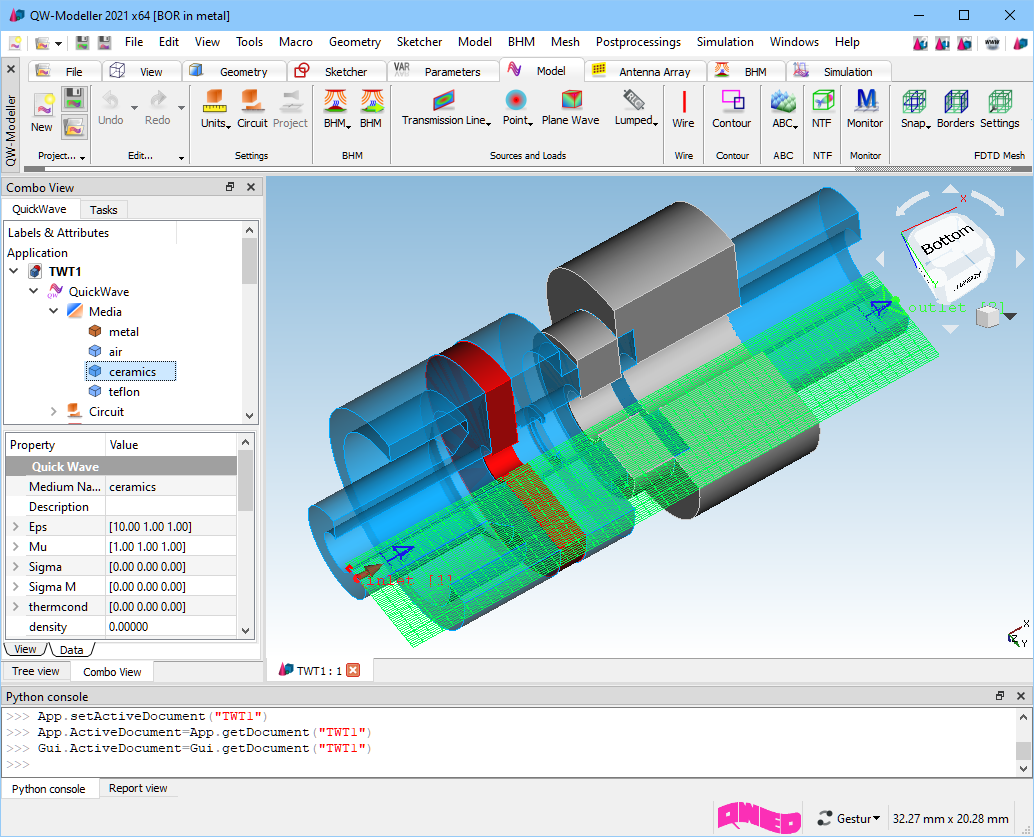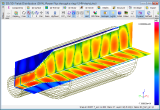QuickWave V2D
Ultra-fast vector 2D electromagnetic solver for axisymmetric (Body-of-Revolution) structures—up to ~2100 wavelengths. Built on conformal FDTD in cylindrical coordinates for rigorous, production-ready results.
Request a QuoteAxisymmetry, mode decomposition, and speed
QW-V2D is a unique, vector two-dimensional solver for analysis of axisymmetrical devices such as horns and rod antennas, biconicals, circular-waveguide discontinuities, and resonators. By defining a 2D long-section and exploiting axial symmetry, simulations run hundreds of times faster than brute-force 3D.
The total field is decomposed into orthogonal angular modes with cos(nφ) or sin(nφ) dependence (n=0,1,2,…). Each n-mode is analyzed independently over one half of the long-section. Note that the n defined here is not a single circular-waveguide mode; for example, a single analysis with n=1 encompasses the composition of all TE1k and TM1m waveguide modes (k,m ∈ ℕ).
What you can compute
- Radiation patterns, gain, efficiency, and return loss of axisymmetric antennas (horn, rod, biconical), with corrugations and inhomogeneous filling fully accounted for.
- Radiation patterns and radiation resistance of small dipoles/loops located on the symmetry axis.
- Accurate S-parameters of circular-waveguide discontinuities, including strong dispersion and multimodal propagation.
- Eigenfrequencies, Q-factors, and pure modal fields for shielded and open inhomogeneous resonators (including closely-spaced and whispering-gallery modes).
- Specific Absorption Rate (SAR) in axisymmetrical bodies.
QW-V2D is widely used in the design of two-reflector Cassegrain antennas for telescopes and communication systems.
Typical axisymmetric problems handled by QW-V2D



Workflow
QW-Editor (2D)
Define the long-section, generate mesh, and set simulation parameters through intuitive dialogs.
QW-Simulator (vector 2D)
Run conformal FDTD, extract frequency-domain parameters, and visualize fields and results.
Defining geometry — four flexible options
- Manual drawing and filling via mouse, menus, ribbon/toolbar.
- UDO scripts (parameterized shapes, variables, loops) — ideal for quick edits and optimization.
- elib library of predefined User Defined Objects; custom objects on request.
- CAD import (DXF → UDO) for industrial workflows (numeric coordinates; edit upstream for shape changes).
Mesh control
Automatic FDTD meshing with user control of global/local cell sizes, snapping planes, and local refinement in regions of rapid field variation.
Visualization
Instantaneous and envelope fields in x–r and r–φ planes, SAR and dissipative power maps, line probes, time-traces, Smith charts and polar plots, and frequency-swept radiation patterns and efficiency.
Numerics & accuracy
- Conformal FDTD in cylindrical coordinates with stable curved-metal modelling (no time-step reduction).
- Higher-order media interfaces and wide-band skin-effect models for lossy metals.
- Spurious-free behavior even with strong spatial irregularities.
- Matched modal excitation via field/impedance templates; differential incident/reflected decomposition and template filtering for clean S-parameters; compensation for imperfect absorbing boundaries.
- Variable-source-impedance technique for pure eigenmodes in inhomogeneous resonators.
- Anisotropic boundary conditions (wire grids) and near-to-far transform from cylindrical to spherical coordinates.
Data export & persistence
Export S-parameters in SuperCompact, Touchstone, CSV, SAC, and GRASP; save eigenvalue charts and antenna characteristics; dump instantaneous fields and 2D/1D envelopes. Freeze a simulation state to pause/resume at any time.
Optional modules
- QProny — Prony-based post-processing for resonant frequencies and loaded Q (ideal for high-Q circular-WG filters).
- QW-OptimiserPlus — parameter optimization of UDO-defined designs with integrated GUI.
- S-Converter — cascade/de-cascade and embed/de-embed multi-file S-parameter operations.
QW-V2D leverages the proven GUI and architecture of QW-3D for a familiar, efficient workflow.
Multicore & GPU acceleration
QW-V2D supports multicore/multithreaded and GPU implementations of QW-Simulator, delivering significant speed-ups on modern workstations.
For platform specifics and deployment options, please contact QWED.
Why V2D instead of 3D?
- Hundreds× faster for axisymmetric structures.
- Modal separation by n ensures clean physics and efficient sweeps.
- Scale to ~2100 λ with high numerical stability.
Ready for your project?
Tell us about your axisymmetric application and requirements. Our team will advise licensing and workflow options.
